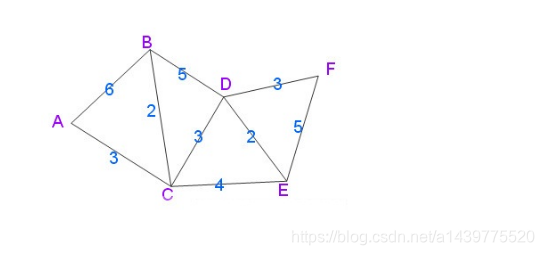1 问题描述
何为spfa(Shortest Path Faster Algorithm)算法?
spfa算法功能:给定一个加权连通图,选取一个顶点,称为起点,求取起点到其它所有顶点之间的最短距离,其显著特点是可以求含负权图的单源最短路径,且效率较高。(PS:引用自百度百科:spfa是求单源最短路径的一种算法,它还有一个重要的功能是判负环(在差分约束系统中会得以体现),在Bellman-ford算法的基础上加上一个队列优化,减少了冗余的松弛操作,是一种高效的最短路算法。)
spfa算法思想:spfa就是BellmanFord的一种实现方式,其具体不同在于,对于处理松弛操作时,采用了队列(先进先出方式)操作,从而大大提高了时间复杂度。 (PS:对于BellmanFord算法可以参考本人的另一篇文章算法笔记_070:BellmanFord算法简单介绍(Java))
2 解决方案
2.1 具体编码
spfa算法寻找单源最短路径的时间复杂度为O(mE)。(其中m为所有顶点进队的平均次数,可以证明m一般小于等于2图顶点个数,E为给定图的边集合)
首先看下代码中所使用的连通图(PS:改图为无向连通图,所以每两个顶点之间均有两条边):

现在求取上图中顶点B到其它所有顶点之间的最短距离。
具体代码如下(PS:下面代码中对于图的处理是直接遍历所有边,如果把该方法变成使用邻接表来实现,时间效率会更好一点)
package com.liuzhen.chapter9;
import java.util.ArrayList;
import java.util.Scanner;
public class Spfa {
public long[] result; //用于得到第s个顶点到其它顶点之间的最短距离
//内部类,用于存放图的具体边数据
class edge {
public int a; //边的起点
public int b; //边的终点
public int value; //边的权值
edge(int a, int b, int value) {
this.a = a;
this.b = b;
this.value = value;
}
}
/*
* 参数n:给定图的顶点个数
* 参数s:求取第s个顶点到其它所有顶点之间的最短距离
* 参数edge:给定图的具体边
* 函数功能:如果给定图不含负权回路,则可以得到最终结果,如果含有负权回路,则不能得到最终结果
*/
public boolean getShortestPaths(int n, int s, edge[] A) {
ArrayList<Integer> list = new ArrayList<Integer>();
result = new long[n];
boolean[] used = new boolean[n];
int[] num = new int[n];
for(int i = 0;i < n;i++) {
result[i] = Integer.MAX_VALUE;
used[i] = false;
}
result[s] = 0; //第s个顶点到自身距离为0
used[s] = true; //表示第s个顶点进入数组队
num[s] = 1; //表示第s个顶点已被遍历一次
list.add(s); //第s个顶点入队
while(list.size() != 0) {
int a = list.get(0); //获取数组队中第一个元素
list.remove(0); //删除数组队中第一个元素
for(int i = 0;i < A.length;i++) {
//当list数组队的第一个元素等于边A[i]的起点时
if(a == A[i].a && result[A[i].b] > result[A[i].a] + A[i].value) {
result[A[i].b] = result[A[i].a] + A[i].value;
if(!used[A[i].b]) {
list.add(A[i].b);
num[A[i].b]++;
if(num[A[i].b] > n)
return false;
used[A[i].b] = true; //表示边A[i]的终点b已进入数组队
}
}
}
used[a] = false; //顶点a出数组对
}
return true;
}
public static void main(String[] args) {
Spfa test = new Spfa();
Scanner in = new Scanner(System.in);
System.out.println("请输入一个图的顶点总数n起点下标s和边总数p:");
int n = in.nextInt();
int s = in.nextInt();
int p = in.nextInt();
edge[] A = new edge[p];
System.out.println("请输入具体边的数据:");
for(int i = 0;i < p;i++) {
int a = in.nextInt();
int b = in.nextInt();
int value = in.nextInt();
A[i] = test.new edge(a, b, value);
}
if(test.getShortestPaths(n, s, A)) {
for(int i = 0;i < test.result.length;i++)
System.out.print(test.result[i]+" ");
} else
System.out.println("给定图存在负环,没有最短距离");
}
}
运行结果:
请输入一个图的顶点总数n起点下标s和边总数p:
1 18
请输入具体边的数据:
1 6
2 3
2 2
3 5
3 3
4 4
4 2
5 3
5 5
0 6
0 3
1 2
1 5
2 3
2 4
3 2
3 3
4 5
0 2 5 6 8